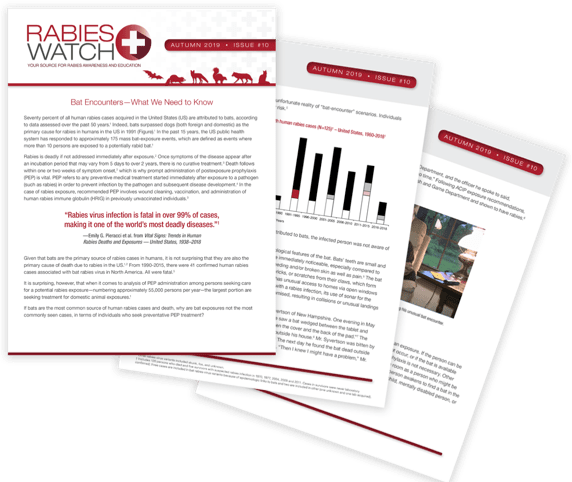MYTH
Thousands of animal rabies cases are reported annually, and 3 human deaths were attributed to rabies in the US in late 2021.1,2
MYTH
Cases of rabies are found on all continents (except Antarctica), with more than 95% of human deaths from the disease occurring in Asia and Africa. In the US, rabies is found in every state except Hawaii.3,4
MYTH
Although the risk of rabies may increase with wound severity, all animal bites, no matter how minor, present a risk of exposure. This is especially true for bat wounds. Bat bites do not always leave a visible mark, and even small scratches and bites are cause for concern.5,6
FACT
Rabies is preventable—but only with proper prophylactic measures.5,7
MYTH
Rabies is preventable through prophylactic measures—but once the clinical signs of rabies develop, there is no treatment.5,7
FACT
Although rare, there have been cases of rabies transmitted to surgical recipients of corneas, solid organs, and vascular tissue transplanted from patients who died of rabies.5
MYTH
Most rabid animals are wild. Common carriers of rabies include raccoons, skunks, foxes, and bats.8
MYTH
Although most rabies exposures are from an animal bite. It is also possible that rabies can be transmitted through scratches, abrasions, or open wounds that are exposed to saliva or other potentially infectious material from a rabid animal.5,6

Common Misperceptions About Rabies Can Lead to Tragic Consequences
For More Answers, Visit the Rabies Watch FAQ Page
Important Safety Information for HyperRAB® (rabies immune globulin [human])
Indication and Usage
HYPERRAB® (rabies immune globulin [human]) is indicated for postexposure prophylaxis, along with rabies vaccine, for all persons suspected of exposure to rabies.
Limitations of Use
Persons who have been previously immunized with rabies vaccine and have a confirmed adequate rabies antibody titer should receive only vaccine. For unvaccinated persons, the combination of HYPERRAB and vaccine is recommended for both bite and nonbite exposures regardless of the time interval between exposure and initiation of postexposure prophylaxis. Beyond 7 days (after the first vaccine dose), HYPERRAB is not indicated since an antibody response to vaccine is presumed to have occurred.
Important Safety Information
For infiltration and intramuscular use only.
Severe hypersensitivity reactions may occur with HYPERRAB. Patients with a history of prior systemic allergic reactions to human immunoglobulin preparations are at a greater risk of developing severe hypersensitivity and anaphylactic reactions. Have epinephrine available for treatment of acute allergic symptoms, should they occur.
HYPERRAB is made from human blood and may carry a risk of transmitting infectious agents, eg, viruses, the variant Creutzfeldt-Jakob disease (vCJD) agent, and, theoretically, the Creutzfeldt-Jakob disease (CJD) agent.
The most common adverse reactions in >5% of subjects during clinical trials were injection-site pain, headache, injection-site nodule, abdominal pain, diarrhea, flatulence, nasal congestion, and oropharyngeal pain.
Do not administer repeated doses of HYPERRAB once vaccine treatment has been initiated as this could prevent the full expression of active immunity expected from the rabies vaccine.
Other antibodies in the HYPERRAB preparation may interfere with the response to live vaccines such as measles, mumps, polio, or rubella. Defer immunization with live vaccines for 4 months after HYPERRAB administration.
Please see full Prescribing Information for HYPERRAB.
You are encouraged to report negative side effects of prescription drugs to the FDA. Visit www.fda.gov/medwatch or call 1-800-FDA-1088
Important Safety Information for HyperTET® (tetanus immune globulin [human])
HyperTET® (tetanus immune globulin [human]) is indicated for prophylaxis against tetanus following injury in patients whose immunization is incomplete or uncertain.
HyperTET should be given with caution to patients with a history of prior systemic allergic reactions following the administration of human immunoglobulin preparations.
In patients who have severe thrombocytopenia or any coagulation disorder that would contraindicate intramuscular injections, HyperTET should be given only if the expected benefits outweigh the risks.
Slight soreness at the site of injection and slight temperature elevation may be noted at times. Sensitization to repeated injections of human immunoglobulin is extremely rare. In the course of routine injections of large numbers of persons with immunoglobulin, there have been a few isolated occurrences of angioneurotic edema, nephrotic syndrome, and anaphylactic shock after injection. Administration of live virus vaccines (eg, MMR) should be deferred for approximately 3 months after tetanus immune globulin (human) administration.
HyperTET is made from human plasma. Products made from human plasma may contain infectious agents, such as viruses and theoretically, the Creutzfeldt-Jakob disease (CJD) agent that can cause disease. There is also the possibility that unknown infectious agents may be present in such products.
Please see HyperTET full Prescribing Information for complete prescribing details.
You are encouraged to report negative side effects of prescription drugs to the FDA. Visit www.fda.gov/medwatch or call 1-800-FDA-1088.
References
- Ma X, Monroe B, Wallace R, et al. Rabies surveillance in the United States during 2019. J Am Vet Med Assoc. 2021;258(11):1205-1220.
- Centers for Disease Control and Prevention (CDC). CDC reports increase in human rabies cases linked to bats in the U.S. January 6, 2022. Accessed July 16, 2024. https://www.cdc.gov/media/releases/2022/p0106-human-rabies.html.
- World Health Organization (WHO). Rabies. Updated June 5, 2024. Accessed July 15, 2024. https://www.who.int/news-room/fact-sheets/detail/rabies.
- American Humane. Rabies facts & prevention tips. Updated August 25, 2016. Accessed July 16, 2024. https://www.americanhumane.org/fact-sheet/rabies-facts-prevention-tips.
- Manning SE, Rupprecht CE, Fishbein D, et al. Human rabies prevention—United States, 2008: recommendations of the Advisory Committee on Immunization Practices. MMWR Recomm Rep. 2008;57(RR-3):1-28.
- Crowcroft NS, Thampi N. The prevention and management of rabies. BMJ. 2015;350:g7827.
- Kaur M, Garg R, Singh S, Bhatnagar R. Rabies vaccines: where do we stand, where are we heading? Expert Rev Vaccines. 2015;14(3):369-381.
- Centers for Disease Control and Prevention (CDC). Clinical overview of rabies. Updated June 20, 2024. Accessed July 16, 2024. https://www.cdc.gov/rabies/hcp/clinical-overview/.